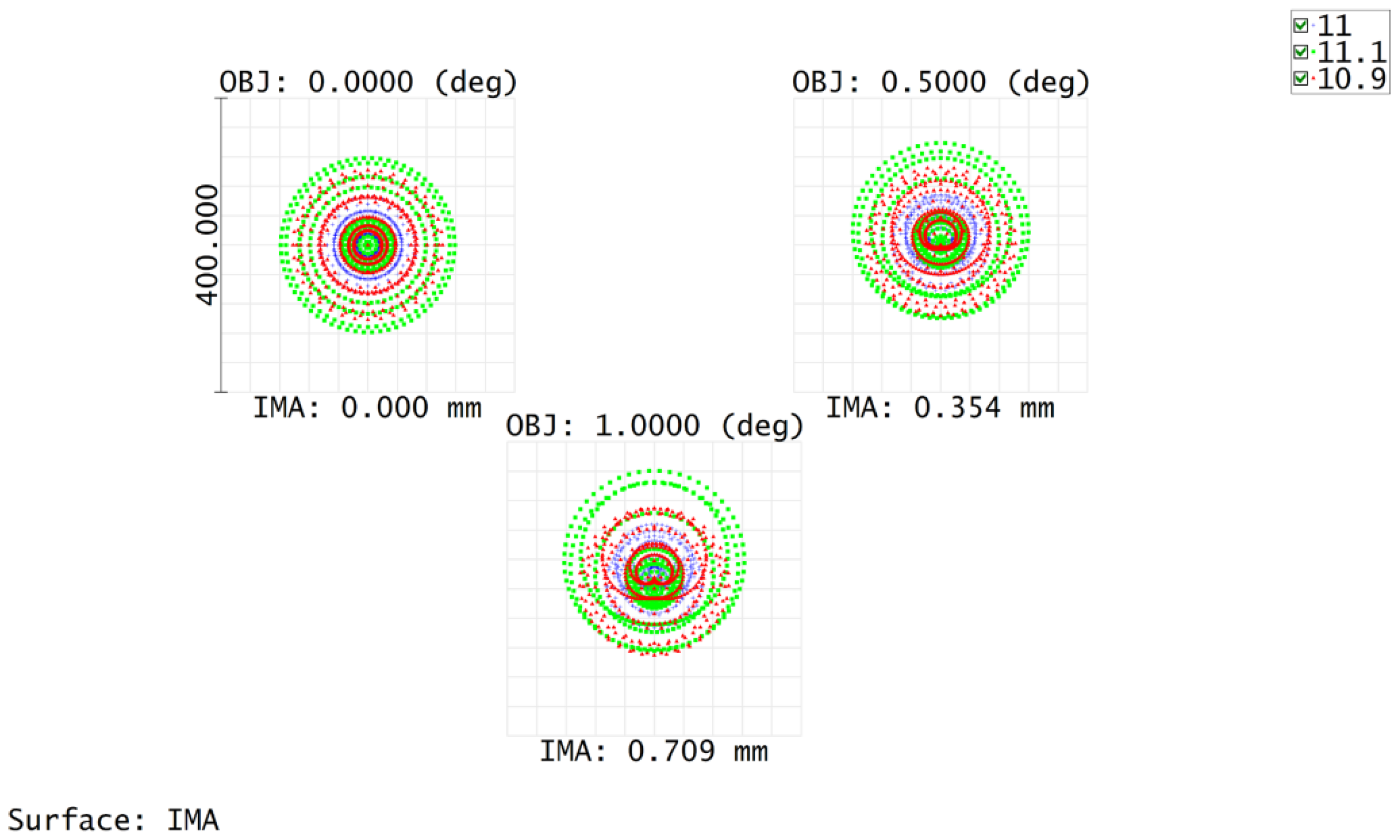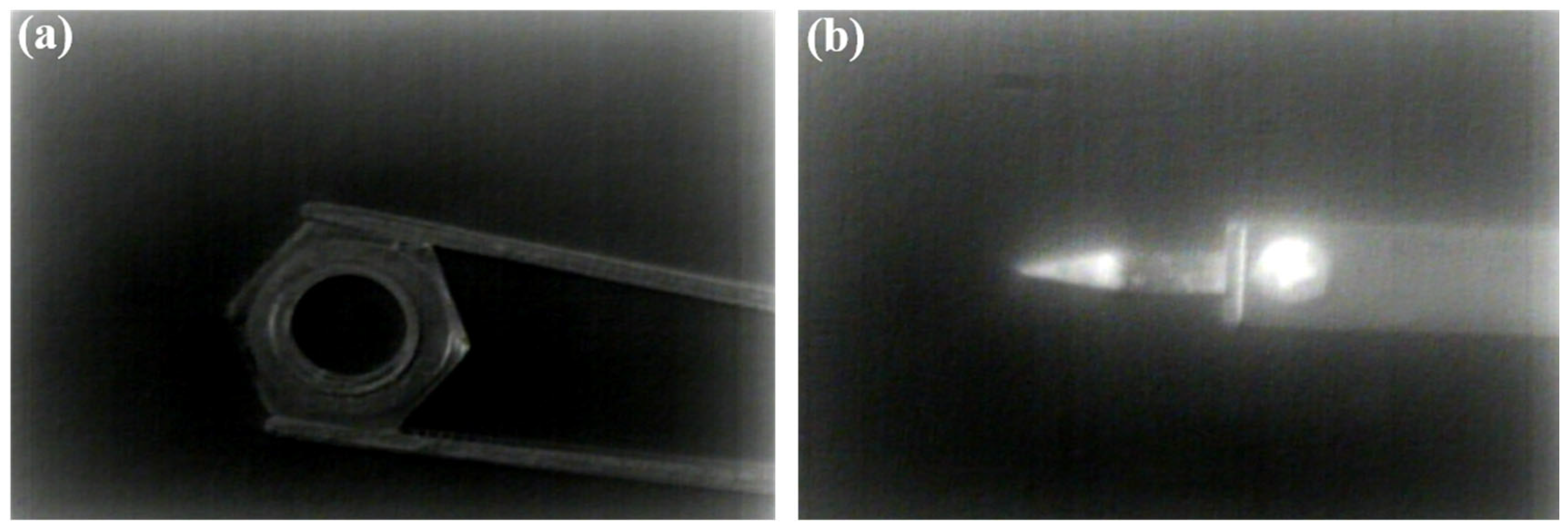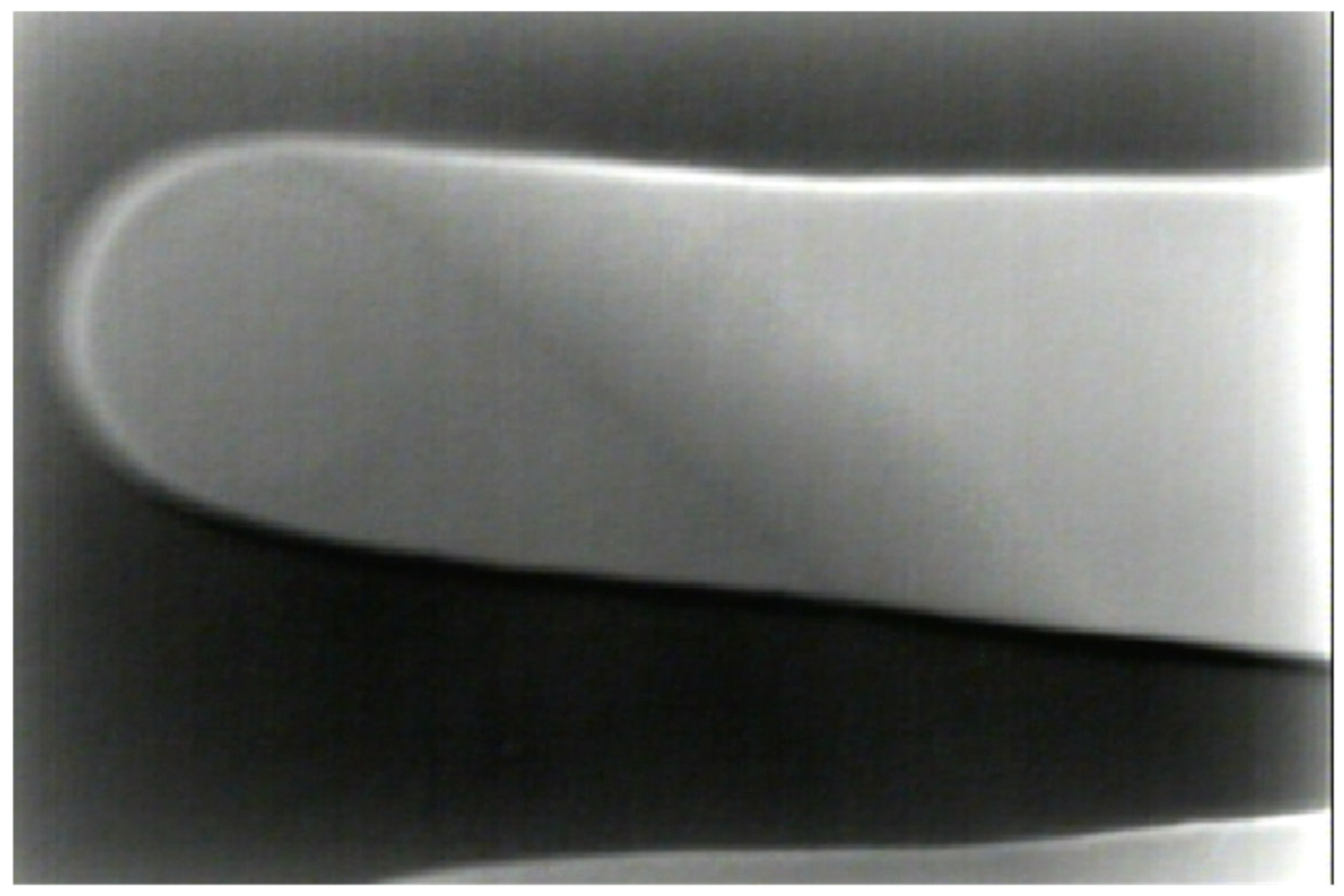1. Introduction
Far-infrared telescopic imaging is a technology that utilizes far-infrared radiation for long-distance target detection and imaging. It operates by capturing the intrinsic or reflected infrared radiation emitted by objects and converting the invisible infrared signals into images by photoelectric transformation. This enables clear imaging in challenging conditions such as darkness, smoke, or complex environments, forming the foundation for the widespread application of infrared detection technology in military, astronomical, meteorological, industrial, and medical fields [
1,
2,
3,
4]. As far-infrared systems passively receive thermal radiation without actively emitting signals, they are difficult to be interfered with, allowing operation during night time, fog, or low visibility conditions.
Traditional optical systems, which rely on the refraction and reflection of light, often suffer from drawbacks such as large volume and heavy weight. Modern optical systems are increasingly evolving toward more compact and lightweight designs [
5,
6,
7]. Planar imaging elements, a long-standing focus in optical engineering, have recently gained significant traction due to breakthroughs in optical manufacturing technology [
8,
9]. Compared to conventional lens designs, these elements offer distinct advantages in miniaturization while reducing the number of required lenses and improving the imaging performance of optical systems [
10,
11]. They have already found broad applications in imaging—for instance, their integration into drones has dramatically reduced system mass and volume.
Emerging technologies like metasurfaces and metalenses are pushing the boundaries further by enabling ultra-thin, lightweight optical components with unprecedented control over light. Compared to traditional lenses, metalenses are capable of focusing on finer details, reducing both the mass and volume of the optical system, while achieving higher-resolution imaging [
12,
13,
14,
15]. However, due to their high fabrication costs and the challenges associated with the design and manufacturing of metamaterials, the practical application of metalenses in real-world engineering remains limited [
16,
17]. In 2022, J. Li from the Institute of Optics and Electronics, Chinese Academy of Sciences, designed a planar optical lens operating in the 10 μm imaging band with a focal length of approximately 100 mm [
18]. However, the metasurface-based approach proved excessively expensive and complex to fabricate. In 2024, M. Hou and colleagues developed a lightweight dual-plane imaging lens for far-infrared applications, specifically targeting gas leakage detection and temperature measurement [
19]. The lens featured a 5 cm aperture, 0.5 mm thickness, and a 0.5 μm bandwidth, achieving an operating distance of up to 18 m with a focal length of 34 mm. Also in 2024, D. Lim at Harvard University fabricated an ultra-thin dual-sided planar focusing lens for the visible light spectrum. With a diameter of 100 mm, a focal length of 150 mm, a remarkable thickness of just 150 nm, and a narrow 7 nm bandwidth, the lens successfully demonstrated focusing capabilities [
20]. In 2025, F. Zhao from the National University of Defense Technology designed a planar imaging lens with a 10–12 μm operating band, a 6.36 cm aperture, and a 20 cm imaging distance [
21]. However, the metalens exhibited limited monochromatic aberration correction ability, resulting in low focusing efficiency and significant energy loss [
22,
23].
Based on the aforementioned research, it is evident that there is a growing demand for lightweight and cost-effective imaging lenses. Utilizing a single-planar optical lens for imaging presents a powerful solution [
24]. Currently, research focused on the far-infrared band remains relatively limited and faces several shortcomings, such as large volume and length—often on the order of tens of centimeters—making it unsuitable for compact structural designs. Diffractive optical elements, known for their unique imaging and thermal characteristics, are widely used in this context. Among them, single-layer diffractive elements achieve diffraction efficiencies exceeding 80%. Compared to metalenses, single-layer diffractive elements can be fabricated using single-point diamond turning, which offers relatively simpler processing [
25]. In 2025, J. Wang and colleagues from the Changchun Institute of Optics, Fine Mechanics and Physics (CIOMP) of the Chinese Academy of Sciences designed a dual-plane imaging lens for the visible light band. The lens featured an aperture of 46.8 mm and a thickness of 3 mm, with an operational bandwidth of 5 nm. To mitigate aberrations, an aperture stop was incorporated on the object side, and the Chevalier Landscape optical structure was adopted to reduce off-axis aberrations [
26]. The total length of the optical system was approximately 180 mm. Their work demonstrates progress in minimizing optical system dimensions while addressing inherent challenges like aberrations in planar lenses.
In this work, we designed a planar optical lens targeting the 10.9–11.1 μm wavelength range with a bandwidth of 0.2 μm, an observation distance greater than 10 m. The surface temperatures of the vast majority of objects around us (such as the human body, buildings, vehicles, and equipment) correspond to thermal radiation peaks that fall precisely within the 8–14 µm wavelength range, with 11 µm located at the center of this band. Detecting within this wavelength range allows for the capture of the strongest thermal radiation signals emitted by objects, resulting in imaging with the highest contrast and sensitivity. In another hand, we only choose a bandwidth of 0.2 µm for our design, as it is easier to control the chromatic aberrations and the imaging energy is enough within this range. First, based on the system’s structural constraints, the optical power requirement was determined. Using the even-order binary surface phase formula, the quadratic phase coefficient was defined, thereby obtaining the phase distribution of the binary surface. Second, the chromatic aberration of the lens was characterized leveraging the negative dispersion properties of the binary optical surface. Third, Ansys Zemax OpticStudio 2024 software was employed to optimize various lens parameters, including focal length and spot size. Subsequently, the phase profile was converted into the surface sag of the lens. To enhance diffraction efficiency and minimize energy loss, a continuous phase surface was fabricated on a single-crystal Germanium substrate using ultra-precision machining techniques. Finally, an imaging system was constructed to achieve clear imaging of various samples. Experimental results demonstrated the far-infrared imaging capabilities, validating the feasibility of both our dual-plane diffractive optical lens and the system.
2. Principles and Methods
In this study, the design wavelength range is 10.9–11.1 μm, with the primary wavelength selected as 11 μm. To ensure high transmittance within this wavelength range, germanium was chosen as the optical material due to its favorable transmittance of approximately 70% in the far-infrared region and a refractive index of 4.0034 at the primary wavelength. The lens aperture is set to 25 mm.
The optical focusing power is primarily provided by a binary optical surface, whose phase profile is described using an even-order polynomial,
where
r is the radial coordinate of the lens,
λ0 is the central wavelength (11 μm in this work), and
Aᵢ represents the phase coefficient for the
i-th order at the central wavelength. The optical focusing power is mainly determined by the first-order coefficient,
where m is the diffraction order (set to 1 in this work), and the focal length is designed to be 43.23 mm. Due to the negative dispersion characteristics of the binary surface, the focal length for other wavelengths
λ is expressed as:
where
f0 is the focal length at the central wavelength. The parameter m mainly determines the diffraction efficiency. In this study, the binary optical surface was fabricated using continuous profiling. The diffraction efficiency of the m-th order relative to wavelength is expressed as:
The relationship between diffraction efficiency and wavelength can be illustrated in
Figure 1, from which we can see that within the wavelength range of 10.9–11.1 μm, the diffraction efficiency exceeds 99.9%, ensuring sufficient energy utilization for practical applications. This high efficiency validates the effectiveness of the continuous-phase manufacturing approach and the design methodology employed.
When utilizing a single binary optical surface for imaging, chromatic aberration is inevitably introduced. The aperture of the designed lens is set to be 25 mm. During the design process, the highest polynomial order used is 8, with a normalized aperture of 100. The coefficients for each order in Zemax are as shown in
Table 1.
Since the normalized radius does not represent the actual physical dimension, a scaling relationship exists between the actual coefficient
Ai and the corresponding coefficient calculated in Zemax, where
Therefore, the actual phase profile can be calculated as follows in Equation (6),
During the fabrication process, the phase is wrapped into the interval [0, 2\pi][0, 2π] and converted into the mechanical surface sag (
r):
where
denotes the modulo operation,
n1 is the refractive index of the lens material, and
n0 is the refractive index of air.
Figure 2 illustrates the surface sag during the fabrication process. It can be observed that the binary optical surface comprises 174 concentric zones, with the maximum sag depth measuring −0.003662 mm. As the radial coordinate increases, the zone density also increases, reaching a maximum of 26.5 zones/mm.
As shown in
Figure 3, the spot diagrams of our planar lens at different field angles are presented. The RMS of the spot diagram corresponding to the diffraction limit of the focal spot is 23 μm. When the field angles are 0°, 0.5°, and 1°, the RMS values of the focal spot diagrams are 62.5 μm, 63 μm, and 66 μm, respectively. To experimentally measure the focusing spot of our diffractive lens, we have developed a system containing a laser source, attenuator, expander, a 4f system and a far-infrared camera. The 4f system behaves as a magnified system, which will enlarge the focal spot for 10 times and thus ensure the sampling points on the camera is enough. The corresponding spot size is calculated to be 66 μm, which is in good agreement with the simulated result. More details are presented
Supplementary File S1. It can be observed that the RMS values across different fields are generally similar, indicating consistent image quality across the entire imaging field. Additionally, the RMS values are approximately three times the diffraction limit, which essentially meets the requirements for imaging applications.
Figure 4 illustrates the three-dimensional Point Spread Function (PSF) of the lens at different field angles of 0°, 0.5°, and 1°, respectively. At a field angle of 0°, the PSF exhibits a peak intensity of 0.3 and a Full Width at Half Maximum (FWHM) of 52 μm. At a field angle of 0.5°, the PSF maintains a peak intensity of 0.3 and an FWHM of 52 μm. At a field angle of 1°, the peak intensity slightly decreases to 0.28, while the FWHM remains stable at 52 μm. The PSF profiles are highly consistent across all field angles, indicating uniform imaging performance from the center to the edge of the field of view. This demonstrates effective control of off-axis aberrations through the aperture stop and phase optimization. The PSF characteristics validate the lens’s ability to deliver spatially consistent and high-contrast imaging across the entire field, meeting practical requirements for far-infrared applications such as gas sensing or thermal imaging. While the resolution is slightly above the theoretical diffraction limit, the performance remains robust for real applications.
3. Experimental Results
The diffractive planar lens, which is shown in
Figure 5, is made of Germanium with an aperture of 25 mm and a lens thickness of 1 mm, resulting in a total weight of 2.658 g. Germanium provides high transmittance (~70%) in the far-infrared range and ensures mechanical stability for the thin planar structure. While we mentioned that the designed lens could reach a high diffraction efficiency, we only compared it with the transmitted light. We did not consider the energy loss by germanium materials. We can apply anti-reflection coatings to enhance transmittance in the future work. This lens is fabricated using Single-Point Diamond Turning (SPDT) with a natural single-crystal diamond tool. Under precisely controlled machining conditions and environment, the SPDT process directly generates aspheric optical components that meet optical quality requirements through single-point turning, enabling single-step completion. For the single lens discussed in this paper, compared to traditional cold processing, no template is required, thereby reducing material waste and improving processing speed. The achieved surface roughness is 10 nm, and the Peak-to-Valley (PV) value of phase variation is 0.5 μm. Together, these parameters ensure the imaging quality of the binary optical surface. The lens weighs only 2.658 g and has a total system length of 44.23 mm, making it highly suitable for weight- and size-sensitive applications. In the design, the focal length of our lens is 43.23 mm, while the thickness is 1 mm. Therefore, we mentioned that the total length of the lens system length is 44.23 mm. In addition, the lens will be mounted on mechanical components and connected to a camera as a whole imaging system. The result of weight comparison of conventional lens and diffractive lens system is presented in
Supplementary File S1.
The experimental imaging system is shown in
Figure 6. The camera model used is the QY62MINI (QiYi Optics, Chengdu, China), with a wavelength range of 7.5–14 μm, a frame rate of 25 Hz, a pixel size of 17 μm, and an operating temperature range of −30 °C to 60 °C. The designed single lens element was precisely positioned based on its focal length and the camera’s sensor plane location.
In the experiment, we performed imaging of metal objects and placed a soldering iron at a distance of 11 m from the lens for long-range imaging. The results are shown in
Figure 7, demonstrating its practicality for applications like remote sensing or surveillance. We also performed far-infrared imaging on human fingers at a room temperature of 26°, as shown in
Figure 8. The ability to resolve metal objects and thermal sources confirms the lens’s effectiveness in distinguishing materials based on infrared signatures. Furthermore, we fabricated a heating line-shaped structure as the measured sample. We placed the line-shaped structure at a distance of 10 m away from the imaging lens, and the linewidth of 0.015 m can be clearly visualized. The corresponding results are provided in
Supplementary File S1.
4. Discussion and Conclusions
Traditional optical systems, based on the refraction and reflection of light, often suffer from the inherent drawbacks of large volume and heavy weight. To address these limitations, this work proposes a design based on diffractive optics on a double-planar substrate. Our approach aims to maintain focusing power while significantly reducing the lens’s volume and mass. We designed a planar optical lens operating in the 10.9–11.1 μm wavelength band with a 0.2 μm bandwidth. The lens specifications include an operational observation distance greater than 10 m and a total track length not exceeding 50 mm. Key parameters of the lens, including focal length and focal spot size, were thoroughly optimized. Binary optical surfaces modulate the phase of incident light waves and induce diffraction by fabricating structures with dimensions comparable to the operating wavelength, thereby enabling precise focusing of the beam at designated positions. The closer the fabricated diffractive surface approximates the ideal designed profile, the more effectively the light waves are modulated, leading to higher energy utilization and improved diffraction efficiency. Consequently, the entire wavefront undergoes phase modulation and converges into an ideal focal spot. The optimized lens phase profile was converted into a corresponding surface sag (height profile). To enhance diffraction efficiency and minimize energy loss, a continuous phase surface was directly fabricated onto a single-crystal germanium substrate using appropriate machining techniques.
The physically fabricated lens was then integrated into an imaging system. This system was successfully used to perform infrared imaging on various samples, including metal parts, an electric soldering iron, and a ruler. These experiments validated the imaging capabilities of the long-wave infrared imaging lens based on double-planar diffractive optics. The methodology presented here holds significant promise for applications requiring miniaturization and lightweight designs, such as infrared imaging, machine vision, remote sensing, bio-imaging, and materials science.













